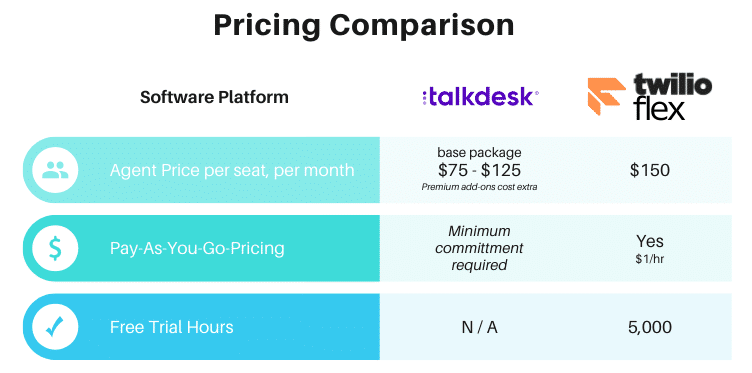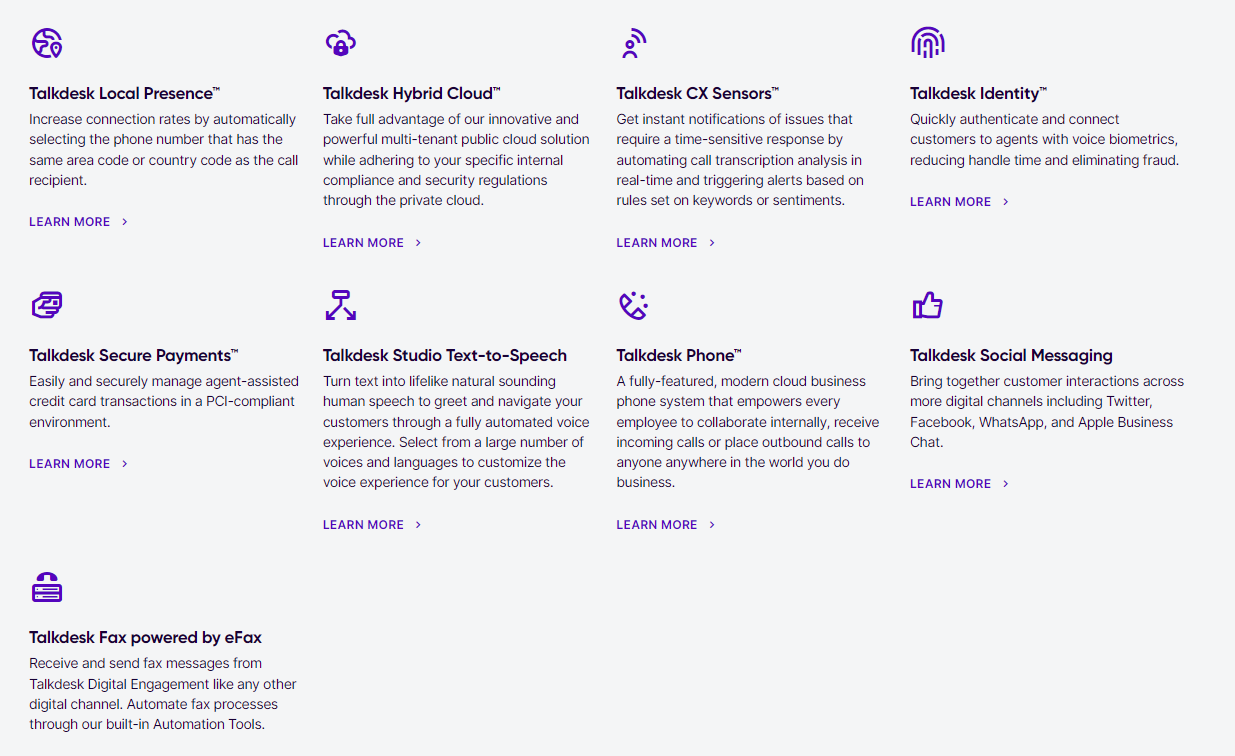Twilio Flex vs Talkdesk: Which to choose?
Choosing the right cloud-based contact center solution for your organization can be a daunting task. There are many factors to consider, such as features, pricing, integrations, support, and scalability. Two of the most popular options in the market are Twilio Flex and Talkdesk. Both of these platforms are considered feature-rich and cutting-edge, but how do they compare and which one is better suited for your needs?
In this blog post, we will compare Twilio and Talkdesk based on their capabilities, advantages and disadvantages, and pricing. We will also provide some tips on how to evaluate and select the best contact center solution for your organization.
Talkdesk was created on Twilio’s APIs

The origin of Talkdesk is remarkable, in that it was actually built using the Twilio platform. Tiago Paiva, the Founder and CEO of Talkdesk, saw that Twilio was giving a MacBook Air as a prize to their hackathon. He wanted to win the MacBook, so he spent 10 days building the first version of Talkdesk using Twilio’s newly released Twilio Client. He submitted a YouTube video of Talkdesk to Twilio and won the contest and the MacBook Air. From there, Talkdesk grew rapidly and raised more funding from various investors. Today, Talkdesk is one of the leading cloud contact center solutions in the market, serving over 1,800 customers worldwide.
Talkdesk is an example of how Twilio enables developers to create innovative and scalable solutions using its APIs and SDKs. However, seeing the success of Talkdesk encouraged Twilio to offer its own cloud contact center product, Flex, which now competes with Talkdesk and other providers in the space.
What are Twilio Flex and Talkdesk?

Twilio and Talkdesk are cloud-based platforms offering contact center solutions for businesses. They facilitate communication with customers through various channels like voice, video, SMS, email, chat, and social media. Both platforms provide tools to manage agents, monitor performance, and enhance the overall customer experience. However, they differ in their approach. Twilio, functioning as a Communications Platform as a Service (CPaaS), provides APIs and SDKs for building customizable contact center applications. Additionally, Twilio offers Twilio Flex, a fully programmable and flexible Contact Center as a Service (CCaaS) solution.
In contrast, Talkdesk, also a CCaaS solution, delivers a user-friendly, ready-made contact center solution with a customizable interface, built-in AI automation, and integrations with specific CRM and helpdesk applications.
What’s the difference between Twilio Flex and Talkdesk?
Understanding the distinction between Software as a Service (SaaS) and Platform as a Service (PaaS) is crucial to understanding how to compare Talkdesk and Twilio. Talkdesk, as a SaaS, delivers fully developed software applications to end-users over the internet, abstracting infrastructure concerns and providing limited control and customization options. On the other hand, Twilio Flex, as a PaaS, offers a platform for developers to build, deploy, and manage applications, providing more control and customization. While Talkdesk users enjoy a ready-to-use application, Twilio Flex users have greater involvement in application development and configuration within the platform. It’s important to note that Talkdesk provides a customizable user interface, built-in AI automation, and integrations with various CRM and helpdesk applications, although it lacks the same level of platform access as Twilio Flex.
Real-World Analogy of SaaS vs PaaS
In the realm of cloud computing, Software as a Service (SaaS) can be likened to a luxurious gym membership, providing users with ready-made features and tools accessible at their fingertips. Much like a high-end fitness facility, SaaS offers a comprehensive package with prebuilt amenities. However, this might present a scenario where users pay for features they don’t necessarily need, desire, or that can’t fulfill their needs.
In the scenario presented, this could be something like a full-sized indoor pool. You ultimately are paying for that pool as a part of your gym membership, whether you use it or not. If you’d like your gym to have a pool, this might suit your needs well, however, if your training regimen required an olympic level sized pool, the gym wouldn’t be able to change these specifications without adjusting this for all gym members. In the SaaS model, the focus is on providing an array of features, typically based on the needs of as wide a net as possible, with the hope that customers will find value in them. This can present challenges for businesses with specific requirements that aren’t fulfilled by the base needs of many.
In contrast, Platform as a Service (PaaS) places a greater emphasis on understanding the specific needs of the user and facilitating the building process towards those requirements. PaaS could be compared to a personal trainer who tailors a workout program to your specific needs. Rather than offering a one-size-fits-all solution, a PaaS provider acts as a fitness expert, taking your inputs and providing you with a framework and tools to craft your own unique solution. The emphasis in PaaS lies in understanding and addressing the individual requirements of the user, allowing for a more customized and targeted approach.
How do Twilio and Talkdesk compare?
To help you compare Twilio and Talkdesk, we will use the following criteria:
- Features and functionality
- Advantages and disadvantages
- Pricing
Features and Functionality Overlap
Twilio and Talkdesk are two contact center solutions that have many features and functions in common. Some of these features are:
- Omnichannel communication
- Call routing and queuing based on agent skills
- IVR and self-service options
- Call recording and transcription
- Agent desktop and CRM integration
- Reporting and analytics
- Quality management and coaching
- Security and compliance
However, there is a difference in how these features are implemented. Talkdesk has these features built-in, while Twilio Flex requires some configuration to enable them.
Twilio Flex Advantages
With a PaaS, there is more flexibility because you have access to a framework rather than a predetermined set of product features and plug-ins. Users can construct their own plug-ins or interface through the APIs of external applications, offering a level of customization not found in SaaS counterparts like Talkdesk. In the case of SaaS, users typically have access to front-end configurations for connecting to other systems or modifying settings.
Customers who have very unique requirements or integrations typically will get stuck in SaaS platforms that are built to only serve the needs of many, or integrate with a certain subset of external systems. We’ve worked with many customers implementing Twilio Flex, here are some examples of features we’ve seen customers request that typically don’t exist on the major SaaS platforms, including Talkdesk
- Anonymization of calls and call log
- Integration with a custom or some niche CRMs
- Internal agent-to-agent chat, similar to Slack or Microsoft Teams
In addition to absent features, another common roadblock is existing integrations that don’t completely fulfill an organization’s needs. SaaS platforms restrict access to the platform level, limiting organizations to the capabilities provided by those systems. For example, if a SaaS integration didn’t fully meet the company’s needs for syncing project-related data between it’s CRM, the company wouldn’t be able to develop a custom integration that precisely aligns with their unique workflow. This would lead to operational inefficiencies and manual workarounds.
Advantages Summarized
- Complete control over a contact center’s design and function
- Endless features and integration options
- Integration options outside of those pre-determined by the platform
Twilio Flex Disadvantages
Utilizing Twilio Flex comes with certain challenges. A Platform as a Service (PaaS) model places a higher reliance on technical skills and setup, making it crucial to choose the right implementation team for building the system and required features.
Additionally, Twilio Flex requires a Single Sign-On (SSO) provider for user management and security, such as Okta, FusionAuth, or Active Directory. In many cases, your organization might already have this in place, and subsequently connecting Twilio to it will not trigger additional charges.
Ohe notable drawback is the absence of a native Workforce Management (WFM) tool in Twilio Flex. While this means additional costs for obtaining a separate WFM tool, it also offers the advantage of flexibility. You can choose and integrate the WFM tool that best suits your needs, potentially one your organization has already invested in.
Disadvantages Summarized
- Greater emphasis and risk on implementation
- Missing native WFM and requires SSO
- Requires coding, development, and design knowledge to set up
- If you don’t have that expertise, you may need to hire someone that does
Talkdesk Advantages
Talkdesk excels in providing a user-friendly and non-technical deployment process. This is beneficial for organizations that prioritize ease of implementation and do not have extensive technical expertise within their teams. Additionally, Talkdesk provides some features unavailable in Flex natively. For example, Talkdesk offers a native Workforce Management (WFM) feature, providing users with built-in tools for managing and optimizing their workforce. This can be advantageous for organizations looking for an all-in-one solution that includes workforce management capabilities without the need for additional third-party tools.
Advantages Summarized
- User friendly and non-technical deployment
- Native WFM feature
- Offers a wide-variety of native integrations
Talkdesk Disadvantages
Unlike Twilio Flex, which allows for a broader range of integrations, Talkdesk’s limitation to integrations within its own ecosystem might restrict organizations with specific external tools or systems they wish to connect. Additionally, the constraint on integration functionality to what Talkdesk provides may limit the scope and depth of integrations for organizations with complex or unique requirements. Organizations may face challenges if they require highly tailored solutions that go beyond the platform’s predefined configurations.
Disadvantages Summarized
- Limits on customization
- Might not be compatible with your 3rd party system
- Restricted functionality on allowed integration
Pricing
Earlier in this blog, we compared the choice between SaaS and PaaS to selecting between a luxury gym and a personal trainer. While these options are easily distinguishable, determining the more expensive one is not straightforward, as either could be the pricier choice. Likewise, the pricing structures for Talkdesk and Twilio may vary depending on the situation. However, we’ll attempt to outline the pricing differences between these platforms.

Base Package Pricing
Talkdesk offers three base-packages: CX Cloud Essentials, CX Cloud Elevate, and CX Cloud Elite, with prices ranging from $75 to $125 per agent per month. Talkdesk also offers solution packages, designed to bundle specific features and configurations for specific industries, such as banking, healthcare, and retail.

It’s important to note that Talkdesk’s base seat licenses do not include certain features, such as those outlined in the picture above and WFM, Customer Experience Analytics, Agent Assist, and Proactive Outbound Engagement, which incur additional costs. For other add-ons, common industry standards are for quotes to be based on expected usage or the number of agent seats, and discounts may apply based on contractual commitments or order volume. Microtransactions, like charges for each pay connector transaction, may also apply. Overall, this makes understanding and determining each customer’s exact monthly costs difficult without receiving a quote.
In contrast, Twilio Flex employs a per seat license model at $150 per agent per seat, without charging on a per-feature basis. Twilio Flex offers a free trial and 5000 free active user hours, and most microtransactions, such as pay connector triggers, are not charged. While Twilio’s cost structure provides predictability, it involves a larger upfront investment, encouraging users to maximize its potential.
Pay-As-You-Go
Talkdesk provides various alternative pricing models, including per-hour login consumption pricing, concurrent pricing, and Digital Engagement-only pricing. These prices are contingent on a minimum 3-year commitment to these editions. It’s important to note that additional telco and usage fees are not included.
On the other hand, Twilio offers a flexible pay-as-you-go model, allowing you to opt for $1 per active agent hour instead of the fixed $150 per agent per seat. Additional telco and usage fees are also not included. This model does not impose any contractual minimums or minimum spend requirements.
How to choose the best contact center solution for your organization?
As you can see, Twilio and Talkdesk have different strengths and weaknesses, and there is no one-size-fits-all solution for every organization. The best contact center solution for your organization depends on your specific needs, goals, budget, and preferences.
To help you choose the best contact center solution for your organization, here are some tips and questions that you should consider:
- Define your requirements and expectations. What are the main features and functionality that you need? What are the communication channels and integrations that you use? What are the performance and quality standards that you have?
- Evaluate your resources and capabilities. How much time and money are you willing to invest? How much technical expertise and support do you have? How much customization and flexibility do you want?
- Compare and contrast the options. How do Twilio and Talkdesk compare and contrast in terms of features and functionality? How are the features you’re interested in going to affect your pricing?What are the trade-offs and benefits of each option for your organization? How do they align with your requirements and expectations?
- Make an informed and confident decision. Based on your research, which solution is better suited for your organization? What are the advantages and disadvantages of your choice? How will you measure and monitor the results and outcomes?
Conclusion
Twilio and Talkdesk are both powerful and popular cloud-based contact center solutions that can help you communicate with your customers and optimize your customer experience. However, they have different features, functionality, reviews, ratings, pros, cons, and pricing that you should be aware of.
In this blog post, we have compared Twilio and Talkdesk based on these criteria and provided some tips on how to choose the best contact center solution for your organization.
Ready to take your contact center to the next level? Vision Point Systems offers expert guidance and implementation services tailored to your preferences. Specializing in Contact Center advisory, we also provide hands-on assistance, including Twilio Flex implementations and integrations for our clients. Take your contact center to the next level with our expertise, and learn more about how we can help you get started today.
